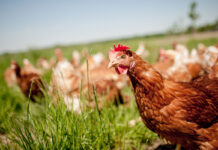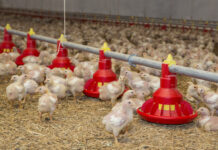
FAO’s publication helps producers use nutrition strategies to reduce the use of antibiotics in their farms. Antimicrobial resistance (AMR) is an increasing threat to both human and animal health, and has reached concerning levels in many parts of the world.
The World Health Organization (WHO) has published the Guidelines on Use of Medically Important Antimicrobials in Food-Producing Animals. These include antibiotics, which are defined as naturally occurring, semi-synthetic or synthetic substances with bacteriocidal or bacteriostatic properties at concentrations attainable in vivo. Antibiotics used in human medicine are categorized as ‘important’ – ‘highly important’ or ‘critically important’. Amongst those classed as critically important to human medicine, there are antibiotics such as aminoglycosides, third- and fourth-generation cephalosporins, fluoroquinolones, glycopeptides, macrolides, certain broad-spectrum penicillins and colistin, all of which are also used with food-producing animals.
AGPs in animal production
Antibiotics are used in animal production as growth promoters (AGPs) and to prevent and treat disease. Van Boeckel et al. (2015) estimated that in 2010, 63,151 tonnes of antibiotics were used in animal production across 228 countries. The authors predict that antibiotic consumption will rise by 67 percent by 2030, and nearly double in Brazil, Russia, India and China, if no additional restrictions on their use are adopted. The WHO thus recently recommended avoiding the use of medically important antibiotics for growth promotion or for prevention of infectious disease that have not yet been clinically diagnosed in food-producing animals, and limiting the use of appropriate antibiotics to the treatment of animals that have been clinically diagnosed with an infectious disease within an herd (WHO, 2017a). The European Commission already decided to ban all AGPs in animal production in 2006.
The preventive and therapeutic use of antibiotics prescribed by veterinarians increased in the first years after the ban. However, countries such as Denmark and the Netherlands responded quickly by implementing additional measures. This included adopting very strict policies for the use of antibiotics, including a ban on the use of medicated feed, and adopting best practices in animal husbandry, nutrition and health care. This multifactorial and multi-stakeholder approach has led to a significant reduction in antibiotic use, whilst maintaining high productivity and animal welfare.
In the United States, the new Veterinary Feed Directive (VFD), implemented on January 1, 2017, restricts the use of all antimicrobial products deemed important to human health for livestock applications. Specifically, such products can no longer be used for growth promotion purposes, and can only be used in feed when a veterinarian, supported by diagnostic procedures, identifies a specific infectious disease and prepares a VFD. Some antibiotics which are not used in human medicine can still be used for growth promotion purposes. A recent report prepared by the U.S. Food and Drug Administration reported that the sale and distribution of medically important antimicrobials decreased by 33 percent from 2016 to 2017 and by 43 percent from 2015 to 2017 (FDA, 2018). A similar approach was adopted in Canada on December 1, 2018, though no information on its impact on antimicrobial use is yet available.
The restricted use of antimicrobials is on the agenda worldwide. Producers are adopting best practices in biosecurity, health care, animal welfare, genetics, farm management, feed handling and animal nutrition to the extent feasible from a practical and economical perspective, as well as an animal welfare point of view. In general, such measures focus on reducing infection pressure in the environment and increasing the animals’ disease resistance and resilience.
Minimizing stress, both social and environmental, well-targeted tailor-made vaccination schemes and, last but not least, health-promoting diets will contribute to disease resistance. Animal nutrition is concerned not only with the provision of the proper amount of nutrients needed for various bodily functions, such as reproduction and growth, but also, given its influence on the functions critical to host defence and disease resistance, with maintaining animal health.
Providing guidance for animal nutrition strategies
The scope of FAO’s publication is to provide guidance for animal nutrition strategies and options that can contribute to a healthy gastrointestinal tract (GIT) in swine, poultry and ruminants, and that will support the defence system of the host during critical transitions, when the risk of health disorders is significantly higher. An improved GIT health in birds can in decrease the need to use antibiotics. Hatching and the two to three weeks post-hatch is a high-risk period in broiler chickens, because the young bird still has to develop a large part of their immune defence system. It is thus not surprising that antibiotic use for enteric problems is relatively high in young animals. Dietary intervention, via feed or drinking water, is a viable option for promoting gut or GIT health and preventing or reducing the need for antibiotics, especially during the critical transition periods.
The other main application of antibiotics is in the prevention and treatment of respiratory disorders. Biosecurity, vaccination and climate control are the more obvious routes to reducing the risk of respiratory infections. However, recent information suggests that there is an important interaction between the gut and lung in host defence. It now appears possible that improving host defence in the gut through nutrition may contribute to higher resistance to respiratory infections.
The FAO’s publication focuses mainly on dietary strategies aiming to reduce the risk of enteric health problems during critical transition periods where antibiotic use is relatively high. The principles of host defence mechanisms that can be influenced and supported by animal nutrition are discussed. The main tools available for diet formulation, and feed and drinking water management are described. Finally, the report discusses in more detail the practical application of dietary tools during critical transition periods in the lives of swine, poultry and ruminants, with an emphasis on the species categories for which antibiotic use is highest.
Information on publication: Smits, C.H.M., Li, D., Patience, J.F. and den Hartog, L.A. 2021. Animal nutrition strategies and options to reduce the use of antimicrobials in animal production. FAO Animal Production and Health Paper No. 184. Rome, FAO.
Here you can find the full document.

















